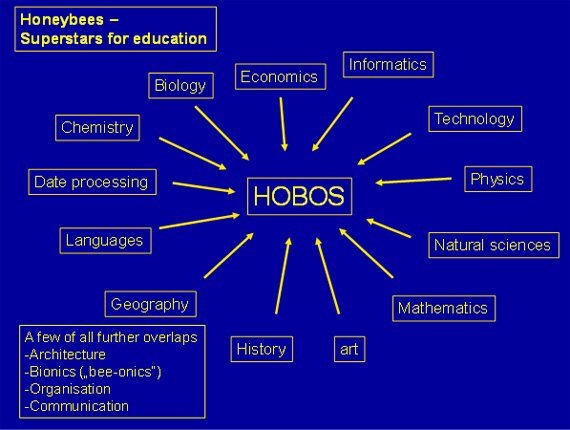HOBOS: A UNESCO-Awarded Learning Project
General education is a process crucial to humanity’s future progress as it offers skills necessary for the success of individuals and of societies, including enhancement of the ability to:
- think critically,
- integrate and synthesize knowledge,
- draw conclusions from complex material,
- understand the natural and physical worlds,
- grasp the processes by which scientific concepts are developed and modified,
- develop the mathematical and quantitative skills necessary for calculation, analytical thought and problem solving.
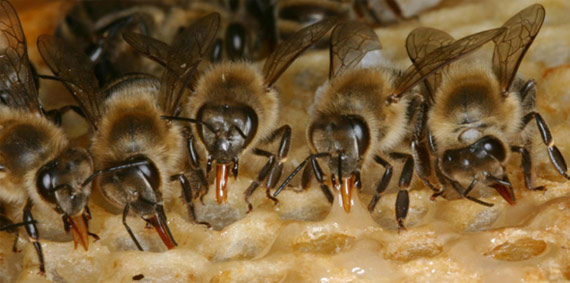
.
These abilities create the foundation upon which all further studies build; therefore, no one can reasonably object to these statements, which are so easy to formulate. However, it is more difficult to answer the question of how to approach these goals. Which teaching/learning strategy is most useful? Which projects are more beneficial to implement?
To answer the first question, our focus will be on exploratory learning. Exploratory learning is a ground-breaking educational concept based on the acquisition of information or behavioral modification as a result of experience. Exploratory learning not only follows the goals we list for general education above, but it also improves one’s powers of observation. For successful exploratory learning, the right tools are essential. Computer simulations are suitable, in-fashion tools as they allow access to an unlimited number of users. But, simulations produce few surprises and the motivation to make new discoveries is low. Studying actual, natural systems would be ideal, but would create a division of students with different opportunities, i.e. those with access to laboratories and relevant set-ups and those without.
To answer the second of the above questions: HOBOS offers the best of these two tools and avoids the disadvantages by employing the computer and the internet. HOBOS makes possible live observations and in-depth study of a highly complex superorganism – the colony of a honeybee. This unique program generates problem-solving skills at all levels, from pre-school to university. It is perfect for interdisciplinary study and research. And, it can be used for projects conducted by individuals as well as projects comprised of tasks distributed by a team of researchers.
Dive online into a living honeybee colony and
- discover phenomena,
- make theories,
- test theories, and
- experience mathematics in nature.
After all this praise, it is time to introduce HOBOS in detail. The core of the HOBOS project are living honeybee colonies, which as superorganisms are among the most complex, but also the most fascinating and important life forms on earth. To watch them even for a short period raises the curiosity of the spectator who wants to learn more about them. Therefore, motivation is NOT a problem when dealing with HOBOS.
Below is justification for choosing honeybees for this learning project, rather than another living organism.
-
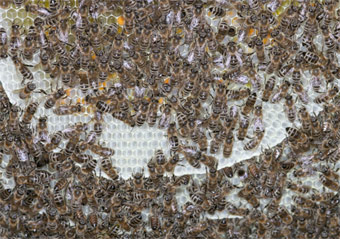
.
Honeybees live as superorganisms in colonies and have fascinated mankind for millennia.
- Honeybee colonies are highly complex systems, which are still far from being fully understood.
- Honeybees are a valuable source for ideas reaching far beyond biology, i.e., architecture, engineering, principles of organization, material technology, mathematics and much more.
- Honeybees are of utmost relevance as flower pollinators, making them indispensable for humankind in food production, i.e., growing fruits and vegetables, and their product derivations. They are of equal relevance for natural ecosystems as pollinators for maintaining wildflower and other biodiversity.
- Honeybees are sympathetic insects known to everyone, and they raise the curiosity of most people.
At the outset of the HOBOS project are webcams, which show colony entrance and all events happening there (in– and out-traffic of bees, communication, meeting of foreign bees, behaviour against intruders, etc.). They also show the sky and vegetation in the vicinity of the HOBOS colonies.
The webcams use thermovision technology, which allows for temperature study of different bee body parts during all actions they perform at the entrance. In addition, two locations inside the colony show all indoor bee behaviours using a light wavelength indiscernible to bees so they are not disturbed.
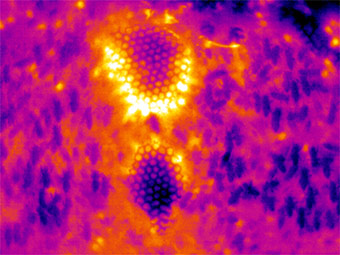
.
The multi-faceted HOBOS approach allows for very complex post-graduate studies or simple projects easily understood and applied by pre-school children. The latter might include: How bright does it need to be outside before the first bees leave the colony in the morning? Do bees ever leave the hive at night? What happens inside the colony when bees are swarming outside?
More than a typical webcam project, HOBOS offers an endless data stream from the following four primary sources: a.) bee colony, b.) weather and soil, c.) vegetation and d.) individual bees. To appreciate the relevance of these data streams some background information on honeybee biology might be helpful, but is not required. With HOBOS a student can either confirm what is already known or make totally new assumptions and discoveries. In addition, data streams have been and continue to be continuously stored on powerful servers throughout the years, thus enabling both historical and live real-time information sharing.
Data from primary sources includes the following:
- Bee Colony
- total weight of the colony
- temperature from 14 positions inside and outside the hive
- humidity inside the hive
- sound inside the hive from two locations
- recording of bee traffic at the hive entrance (counting bees leaving and returning)
- Weather and Soil
- temperature
- humidity
- wind direction
- wind speed
- leaf wetness
- atmospheric electric field
- sun-radiation
- air pressure
- soil temperature
- soil volumetric water content
- Vegetation
- This data is derived from the HOBOS garden. Here sensors listen into the plants for their water demand and other parameters relevant for nectar production, which is, in turn, relevant for the foraging activity of the honeybee colony.
- Individual Bees
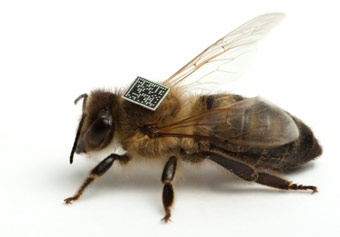
.
- This information stream includes radio-frequency identification (RFID) and Datamatrix bees data. Thousands of individual bees equipped with RFID chips or Datamatrix codes provide data on lifespan, on behaviors of all these bees, on circumstances of their individual development and so forth.
Answers from these data sets may constitute a totally new scientific breakthrough. The lists of questions for scientific development are endless and could include, for example:
- How do forager bees behave prior to an upcoming thunderstorm, and how much time before the thunderstorm do they exhibit this behavior?
- Is humidity constant inside the colony, or is there a circadian rhythm?
- What time of day do drones leave the colony?
- How does the weight of the colony change if the bees cannot leave the hive for several days due to inclement weather?
- What are the parameters of flight activity time course during a day? Examples for details to be studied within this context could include:
- When do the first bees take off in the morning?When is the maximum out-flight activity?
- When is the maximum return-flight activity?
- Is there more than one maximum/minimum flight activity during one day?
- How are the above questions impacted by external temperature?
- How are the above questions impacted by temperature inside the hive?
- How does the above change throughout the year?
- How do different rainfall intensities influence flight activity?
- How do different wind intensities influence flight activity?
- Can certain noises be recorded from inside the colony before the first bees leave in the morning?
- Do some bees inspect the exterior in front of the hive prior to forager bees’ morning flight?
- Do bees ever return to the colony at night?
- Are there special sounds inside the hive prior to swarming behavior?
- Do the first forager bees leave the hive in the morning strictly at a certain time of day, or at a certain brightness outside the hive, or at a certain temperature outside the hive?
- Is the loss of total colony weight in winter different between day and night?
- When is the CO2-concentration inside the hive maximal? Does this correlate with maximal flight activity of forager bees? Or, does this correlate with the temperature inside the hive, or the outside temperature, or with none or both?
- Do the forager bees extend their flight activity into the night during full moons?
-
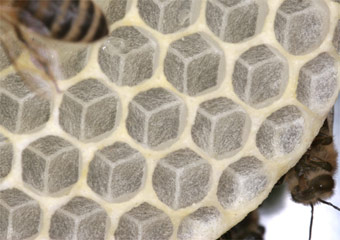
.
How big is the daily loss (or gain) in number of bees, and how does this change throughout the year? Are these numbers influenced by rainfall or air temperature?
- What determines the start of foraging flights in the morning? Is it the light intensity, the temperature outside the colony or something else?
- How much weight does a colony lose when a swarm leaves?
- Where inside the colony is the temperature almost constant, and where does it fluctuate?
- Wasps occasionally attack bee colonies. Are these attacks accompanied by specific bee sounds inside the colony, possibly recruiting defenders to the entrance?
- Forager bees walk out of the colony and start flying when outside in front of the hive. Their flight muscles must be heated up for flight performance. Do they raise the temperature of their flight muscles shortly prior to lift-off, or are they heated up already when walking out of the colony?
- Solar radiation (direct sunshine) is one of the parameters recorded by HOBOS, thus allowing the following questions: Do forager bees return into the colony in greater numbers when the sun is blocked by clouds? If so, how long after the vanishing of direct sunshine does this occur?
- At which wind speed do bees stop foraging and return into their hive?
- Is the oxygen concentration inside the hive constant during day and night, or does it fluctuate?
- How much colder do forager bees return to their hive, compared to the body temperature of departing bees? Does this temperature difference depend on the outside air temperature?
- Is the flight activity of the bee colony reduced when clouds move in front of the sun?And, HOBOS can go still further in the pursuit of educational exploration. Thousands of bees will be raised in two groups as pupae in special incubators at 33 and at 35 degrees Celsius. We will mark each bee individually by RFID chips (see beginning photo). The HOBOS user can then follow individual bees throughout their lives, thus allowing for an even more specific set of questions, such as:
- What is the age distribution among bees performing the so called “mass orientation flights” during noon?
- Are bees raised at lower temperature busier foragers?
- Do bees raised at higher temperatures live longer?
- How long after their birth do bees leave the colony for the first time?
- How long do they stay outside the colony at their first flight?
- Do different bees have different preferential outside temperatures for leaving the hive?
- Are there “rain specialists,” i.e., bees that leave the colony in weak rainfall?
- Do some bees make more foraging trips than others?
Obviously, the questions and study areas are only limited by one’s imagination, thus allowing for highly specific and custom-oriented study programs.
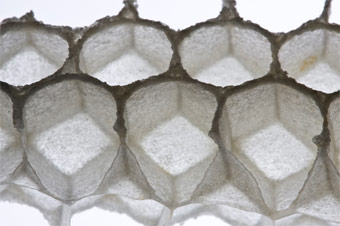
.
The HOBOS team makes constant suggestions on what to study with the life colonies, in addition to developing packages of texts, photos and video-clips as background information to the events and processes HOBOS transmits from the honeybee colony. The program continuously supplies online data from the honeybee hives ranging from simple information to in-depth studies of the highest order and ambition. As mentioned, users can either follow suggestions on projects at various difficulty levels provided by the HOBOS staff, or they can follow their own study agenda with any question or questions they are interested in. Thus, HOBOS allows for a range of projects from simple and very time-limited to highly complex and scientifically ambitious. In addition, projects can be followed over years, which make the process even more interesting, challenging and rewarding.
And, HOBOS is not a pure biology project. The honeybee-supplied data streams are especially useful mathematics teaching tools ranging from simple calculations to very complex graph analysis to all levels of statistical difficulty and graph constructions.
The complex superorganism honeybee colony is an excellent source for data mining, thus providing teaching and training in this sophisticated methodology. A stock market cannot be more complex. In addition, HOBOS offers links and connections to further disciplines, such as physics, chemistry and technology.
This makes HOBOS a truly interdisciplinary teaching tool, which opens up options the student may not have previously considered – all thanks to the instant interest and primary motivation resulting from the fascination of a living honeybee colony.
YouTube: High Speed Summary, Life Inside the Beehive
HOBOS now contains the first math section. Please go to http://www.hobos.de/de/lehrer-schueler/lehrmaterial/gymnasium.html and scroll down to BLOCK 3 (MATHEMATIK): Geometrie der Waben der Honigbiene.
For the moment it is only available in German, but it will be available in English soon.
The list of countries using/interested in using HOBOS to teach K-12 science, technology, engineering and math (STEM) concepts and skills within a sustainable environment continues to grow every day. According to Professor Tautz, the newest countries with interest include Chile, Czechia, Slowakia and Jordan. In fact, HOBOS is privileged to have H.R.H. Princess Basma bint Ali of Jordan as an outstanding patron. Her Royal Highness is a world-renowned, respected environmental advocate who is known to be a diligent worker for the future of nature and mankind. HOBOS is expected to officially start in Jordan on July 2, 2011, with its first two partner schools, the Baptist School of Amman in Jordan and the Friedrich Koenig Gymnasium in Wuerzburg, Germany. Dr. Nizar Haddad, the bee research unit director of Jordan, will supervise the project in Jordan and the Arab countries.
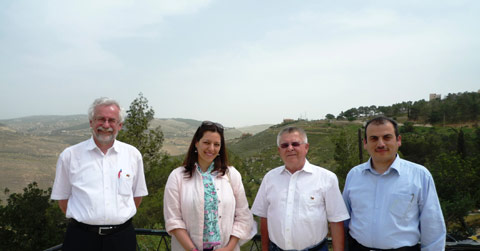
|Teaming up for HOBOS: H.R.H. Princess Basma bint Ali from Jordan, patron of the international HOBOS project, standing with Prof. Jüergen Tautz (left), founder and director of the HOBOS project, Ernst A. Hestermann (2nd from right), manager of HOBOS and Dr. Nizar Haddad (right), HOBOS supervisor in the Arab world.
HOBOS’ international presence provides sponsors an opportunity to reach and to influence K-12 and post-secondary youth across the globe. For more information on becoming a HOBOS sponsor, please contact Tautz via email at Tautz@biozentrum.uni-wuerzburg.de or via his contact information below:
BEEgroup Universität Würzburg
Am Hubland
D-97074 Würzburg
www.hobos-online.de
www.beegroup.de










